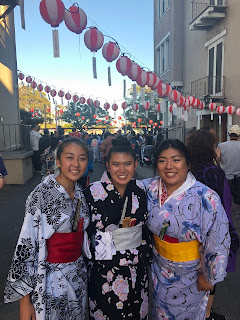I Belong, But Do I Really?
Something about me is that I am fourth generation Japanese American.
I was born here, my parents were born here, and their parents were born here.
Everyone I meet here accepts and sees me as Japanese. When reading “Literacy,Discourse, and Linguistics” by James Paul Gee, I began reflecting on my life
and how many Discourses I have used throughout my life and just how much I ‘mushfake,’
or “making do with something less when the real thing is not available” (13) in my daily life. There are so many times I have
to mushfake my way through conversations simply because I don’t know what
people are talking about, particularly with pop-culture trends that I just haven’t
heard of, or about music artists that I don’t listen to because I’m not really
into that genre of music, but everyone around me does.
 |
| Me with friends in Japanese yukata at a festival at our church to celebrate our ancestors |
There is one particular part of Gee’s article that that stood out to me as I was reading. He wrote, “…someone cannot engage in a Discourse in a less than fully fluent manner. You are either in it or you’re not. Discourses are connected with displays of an identity; failing to fully display an identity is tantamount to announcing you don’t have that identity, that at best you’re a pretender or a beginner” (9-10). This popped out at me because I immediately thought back to the trip to Japan that I took between my junior and senior year of high school. For me, because I think of everyone born here as American, when people ask me ‘what are you?” I know that they are asking about my ethnicity, so I automatically say I am Japanese.
 |
| My group taking one last group picture with the groups from Hawaii, Canada, and Brazil. |
The trip I went on was a youth trip with my church, so it
was a group of mostly Japanese American teenagers and young adults, and our continental
US delegation met up with other delegations from Hawaii, Canada, and Brazil. The
majority of participants were of Japanese ethnicity, but when we arrived you
could clearly pick us out of a crowd. It was very clear that we were not Japanese
from Japan, but Japanese from another country.
 |
| Me and my homestay sister, who is my friend and part of the group I went with, and our homestay parents on the last day we spent together before she and I left for the next part of our trip. |
 |
| In the left picture, I am with the Bishop of the US branch of my church (Hawaii has their own) and another friend that came with our group. |
 |
| The presentation of food is also different, and meals were composed of individual plates that held small portions of different dishes. |




Great post, Kiyomi, and I enjoyed the story. It reminded me of two things: 1) I thought of my trip to England a few years ago. My great-grandfather was born in England, and as I traveled, I saw glimpses of my culture, but it wasn't really my culture. Almost, but not quite. I am English, but I am not English. I am American. (Actually it turned out that my DNA is not English, which is really confusing, but that's another story. He was raised there, and so culturally, there's that.)
ReplyDeleteOn the other hand, I do fit into the dominant culture here, and so I don't think about these things so much.
2) The other thing I thought about was I watched Crazy Rich Asians last weekend, and the protagonist is a Chinese-American. Her Chinese-born mother tells her that she may look Chinese, but she is not. The protagonist doesn't believe her mother until she goes to Singapore, and then it all makes sense. She is more American than she is Chinese. She loved Singapore, and she felt like she almost fit, but not quite. And then I thought about you and how odd --and at the same time wonderful--it must have been to travel to Japan.
I think there is a new way of being American that doesn't always include English-Western-European culture, and I think that is good.
It's late, and I am rambling, so I think I will stop now.